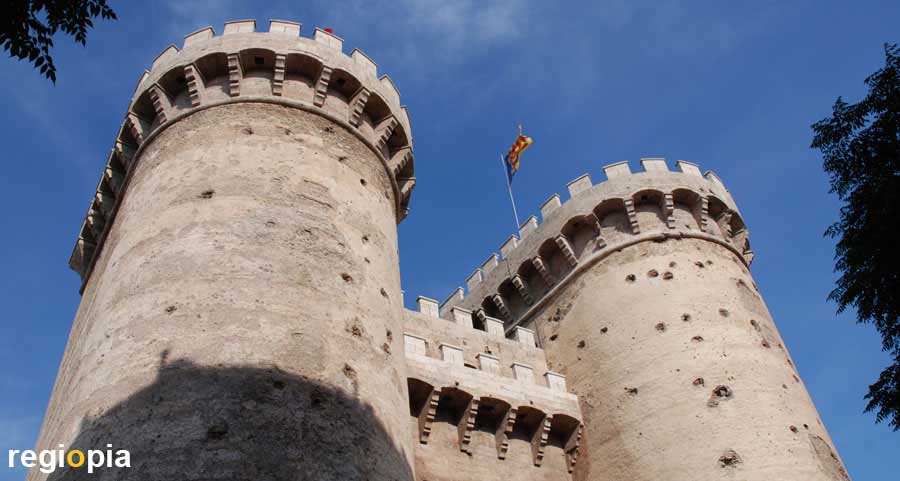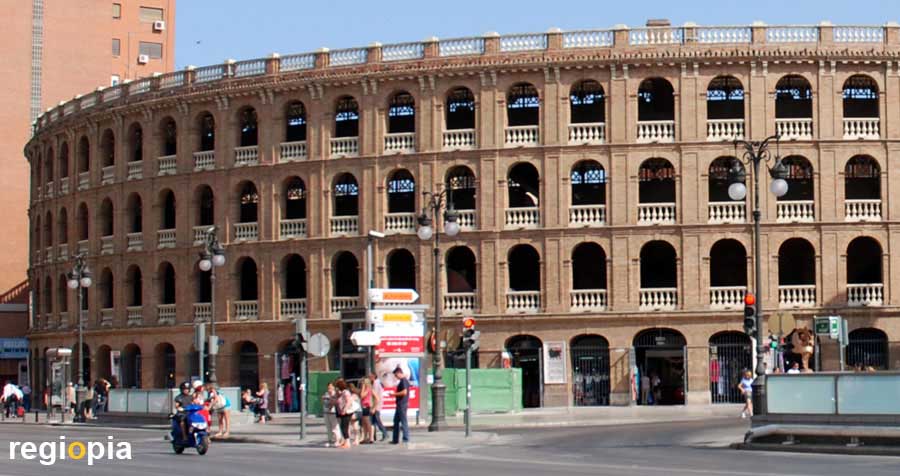
Catedral de Santa Maria de Valencia
Construction of the Valencia Cathedral began in 1262. The cathedral of Valencia is oriented neither towards Jerusalem nor towards Mecca. The structure lies on a southwest-northeast axis. The Gothic church was completed in the middle of the 15th century. At the same place there was previously a Roman temple and later a mosque of the Muslim conquerors. The west facade was not completed until 1741 in the baroque style. The Holy Grail, which is said to have come to Valencia via detours from the Holy Land, is kept in the Cathedral of Valencia. Whether the story is true or not cannot be proven. The dome of the Chapel of the Holy Grail "Capella del Santo Caliz" is worth seeing. The interior of the cathedral is very unusual. The nave is relatively low and covered with Gothic vaults, while the interior design alternates between Gothic, Renaissance and Baroque. From the outside, the cathedral looks strangely unfinished and composed of parts that don't really fit together. There is an entrance to the north from the square Plaça de la Mare de Déu in Gothic style and an entrance from the south in Baroque style. The Chapel of the Holy Grail is on the right if you choose the south entrance.

Lonja de la Seda
The Silk Exchange is the city's most important building and has been a UNESCO World Heritage Site since 1996. The "Lonja de la Seda" was founded in 1469. Construction began in 1483 and was completed in 1533. The silk trade was the largest employer in Valencia at the time. The traders must have been very rich to be able to afford such a structure. The interior is particularly worth seeing because of its twisted supporting pillars that are reminiscent of palm trees. The ceiling of the 17 m high hall was painted with green leaves and a dark blue night sky with twinkling stars. Next to the "Lonja de la Seda" is the "Consolat de Mar", a maritime tribunal that met in Valencia since the 13th century.

Torres de Quart
The "Torres de Quart" are remains of the old city walls around the historic center of Valencia. The western city gate was built between 1441 and 1466. The bullet holes from the French siege of 1808 are still clearly visible. The name "Torres de Quart" refers to the village of Quart that is now a district of Valencia. You can visit the old watchtower, from which you have a beautiful view of the center of Valencia.

Torres de Serranos
The northeastern city gate "Torres de Serranos" was completed in 1391 and is one of the largest Gothic city gates in Europe. It was the most important of the 12 gates that guarded medieval Valencia. The road from the north that leads along the coast to Barcelona ran towards the "Torres de Serranos" (mountain towers). At that time, the port of Valencia was located just behind the city gate on Turia river. In 1865 the city wall was torn down and 10 of the 12 city gates also had to give way. The Rio Turia was diverted in 1985 and a park was created in the old river bed. The "Ponte dels Serranas" bridging today the Garden Jardin del Turia. The two octagonal towers of the "Torres de Serranos" are connected by a gallery. The watchtower also served as a prison and can be visited. From the Torres de Serranos you can see the cathedral and the Ciudad de Artes y Las Ciencias.

Mercado Central
The wonderful Mercado Central with its incredible range of fresh food is a must-see of Valencia. The Central Market is one of the most beautiful market halls in the world and one of the top attractions of Valencia. In addition to fruit, vegetables, baked goods, meat and fish, there are also snacks for take away. Tip: between exits 3 and 4 is the Central Bar by star chef Ricard Camarena, where you can get delicious tapas, bocadillos and other small delicacies. The huge Art Nouveau hall (in spanish called Modernismo) was opened in 1928. The market opens from 7:30 am to 3:00 pm, closed on Sundays.

Convento de Santo Domingo
The rather unassuming Convento de Santo Domingo at Plaza de Tetuán, is a very beautiful monastery. The cloister with its green courtyard and richly decorated gothic arches is well worth a visit. In the background of the photo, you can see the tower of the monastery.

Santo Tomas
Santo Tomas recalls the Baroque church "Il Gesù" in Rome, built in 1580. The church of Santo Tomas is also known as "Iglesia de la Congregación" and was completed in 1736. The stone with a slight red shade, makes Santo Tomas one of the most beautiful churches in Valencia.

Plaza del Ayuntamiento
At the triangular Plaza de Ayuntamiento are all the magnificent buildings from the beginning of the 20th century, such as the town hall, the main post office and large hotel and office buildings. Even the sidewalks are partly made of polished marble. The Plaza de Ayuntamiento is a very elegant square and the city center of Valencia. During the spring festival there is a fireworks display every day at 2 p.m.
The neoclassical City Hall (Ayuntamiento) of Valencia was built in 1758 and given a uniform facade in 1906. The town hall balcony was added in 1960. The marble staircase and the large ballroom are well worth seeing. The City Hall is also home to the Valencia Historical Museum (Museo Histórico de la Ciudad). To the right of the main entrance is the Valencia Tourist Office.

Palacio de Comunicaciones
The main post office "Palacio de Comunicaciones" from 1922 combines many historical architectural styles. The eclectic building was designed by the architect Miguel Angel Navarro. The monumental main hall is spectacular and is spanned by a huge glass dome. The building still serves as a post office, if you want to buy stamps you can do so here. Correos y Telegrafos Letters and Telegrams is written above the portal. The metal tip on the post office actually served as an antenna.
ads

Estacion del Norte
Valencia Central Station is in the south of the old town. The terminus "Estacion del Norte" was opened in 1917 by the railway company Ferrocarrils del Norte. The train station is a fine example of Modernismo, as Art Nouveau is called in Spain. The facade is decorated with orange blossoms as a symbol of Valencia and the star for the railway company. In the interior you will find beautiful tile pictures with motifs from the area around Valencia. About 800 m south of the Estacion del Norte a new station for the high-speed trains AVE was built. This station is called Joaquin Sorolla. As a result, the station "Estacio del Nord" was devalued and the plan is to build the new "Parque Central" on the old tracks.

Plaza de Toros
The "Plaza de Toros" bullring was opened in 1851, but the building was not finished until 1860. The round arena, somewhat reminiscent of the Coliseum in Rome, has a diameter of 52 meters. The arena offers over 12,800 seats. Catalonia has banned bullfighting in 2012, since then the area lost its main purpos. In the Museo Taurino you can find out more about the history of bullfighting. But there are nowo other events taking place in the "Plaza de Toros" of Valencia.

Veles e Vents
For the America's Cup 2007 the british architect David Chipperfield built the headquarters of the sailing regatta. Under the offset level, the spectators were protected from the sun and could attend the events. The port of Valencia Puerto Autonomo was expanded to include the "Marina Real Juan Carlos I" for the America's Cup. The area north of the harbor basin has been upgraded and restaurants near the beach are attracting visitors.

Palau de les Arts Reina Sofia
The Valencia Opera House was built in 2005. It is the largest opera house in Europe and like all buildings in the "Ciudad de Artes y Las Ciencias", it was designed by Santiago Calatrava. There are four halls in the building, the largest of which can accommodate 1,490 spectators. In the "Palau de les Arts Reina Sofia" around 3,600 visitors can attend cultural events at the same time. The Palau de les Arts is the northernmost part of the Ciudad de Artes y Las Ciencias. Due to the curved roof, the egg-shaped building is one of the most striking structures in the city.

L'Hemisferic
The IMAX cinema and planetarium "L'Hemisferic", modeled on an eye, was built in 1998 as the first building in the Ciudad de Artes y Las Ciencias, known as CAC by star architect Calatrava. The spanish architect Santiago Calatrava studied in Valencia, but he lives now in Zurich. L'Hemisferic stands in a pool of water that connects all of the CAC's structures. The "Ciudad de Artes y Las Ciencias" was built in the former river bed of the Rio Turia. The eye of L'Hemisferic starts to shine in the evening when the cinema-goers stream into the building. You can find the cinema program of the Hemisferic in the link to the CAC below.
Ciudad de Las Artes y Las Ciencias

L'Agora
The last building of the "Ciudad de Artes y Las Ciencias" was the multi-function hall L'Agora. The building was opened in 2009 and, like the other structures, it was designed by Santiago Calatrava. Events such as ATP tennis tournaments or the Valencia Fashion Weeks take place here. But the agora hall is not used very often. The glass roof of the agora can be opened, but it is not completely sealed, sometimes rain falls into the hall. But it doesn't rain often in Valencia. Another building of the CAC is the "Museo de la Ciencias Principe Felipe" which you can find under the category > Museums in Valencia
Tourist Map of Valencia
ads
Travel Guide Valencia
Welcome to Valencia
With around 800,000 inhabitants, Valencia is the third largest city in Spain following Madrid and Barcelona. Valencia is also known as the city of paella, the Spanish national dish. The historic center is well preserved and has many beautiful buildings, squares, churches and markets to offer. With the "Ciudad de Artes y Las Ciencias" by Santiago Calatrava an architectural masterpiece was created in the old river bed of the Turia.
ads
Discover Valencia
Museums
In addition to the many sights, Valencia also has some interesting museums to offer. Art lovers will discover beautiful paintings in the Museo de Bellas Artes San Pio V, for those who are interested in the history of Valencia the Museo d'historia de Valencia and technology fans will find what they are looking for in the Museo de la Ciencias Principe Felipe.
Gardens and beach
Downtown Valencia is surrounded by a park that used to be the Turia River. This was diverted after severe flooding and turned into a park. The botanical garden is also very recommendable with many plants that we do not have. The best is of course the Playa de Levante beach, which is not far from the center.
ads


